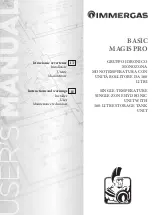
51
LP- 276 REV. 9.4.14
Sodium:
20 mGL
B. CHECK FOR GAS LEAKS
Before starting the boiler, and during initial operation, smell near the floor and around the boiler for gas odorant or any unusual odor.
Remove boiler front door and smell interior of boiler enclosure. Do not proceed with startup if there is any indication of a gas leak.
Repair any leaks at once.
PROPANE BOILERS ONLY – Your propane supplier mixes an odorant with the propane to make its presence detectable. In some
instances, the odorant can fade, and the gas may no longer have an odor. Before startup (and periodically thereafter), have the
propane supplier verify the correct odorant level in the gas.
C. CONDENSATE REMOVAL
1. The boiler is a high efficiency condensing boiler. Therefore, the unit has a condensate drain. Condensate fluid is nothing more than
water vapor, derived from combustion products, similar to that produced by an automobile when it is initially started.
Condensation is slightly acidic (typically with a pH of 3 to 5) and must be piped with the correct materials. Never pipe the condensate
using steel, copper, brass or other materials that will be subject to corrosion. Plastic PVC or CPVC pipe are the only approved
materials.
A condensate neutralizer, if required by local authorities, can be made up of lime crystals, marble or phosphate chips that will neutralize
the condensate. This may be done by the installer or you may purchase a condensate neutralizer from HTP (7350-025).
2. The boiler is equipped with a ¾ FPT connection that must be piped to a local drain. It is very important that the condensate line is
sloped downward away from the boiler to a suitable inside drain. If the condensate outlet on the boiler is lower than the drain, you must
use a condensate removal pump, available from HTP (554200). This pump is equipped with two leads that can be connected to an
alarm or another type of warning device to alert the user of a condensate overflow, which, if not corrected, could cause property
damage.
3. If a long horizontal run is used, it may be necessary to create a vent in the horizontal run to prevent a vacuum lock in the condensate
line.
4. Do not expose the condensate to freezing temperatures.
5. It is very important you support the condensation line to assure proper drainage.
D. FINAL CHECKS BEFORE STARTING BOILER
1. Read Startup Procedures within this manual for proper steps to start boiler. (See Startup Report to record steps for future reference.)
2. Verify the boiler and system are full of water and all system components are correctly set for operation.
Ensure the boiler is full of water before firing the burner. Failure to do so will damage the boiler. Such damage IS NOT covered by
warranty, and could result in property damage, severe personal injury, or death.
3. Fill condensate trap with water.
4. Verify electrical connections are correct and securely attached.
5. Inspect intake piping and exhaust piping for signs of deterioration from corrosion, physical damage or sagging. Verify intake piping
and exhaust piping are intact and correctly installed per Venting Section and local code.
E. SETTING UP A SINGLE BOILER
When power is applied to the boiler, the control first completes a power-up systems check. During this time the combustion fan may
run. The display will initially show the current boiler outlet temperature. If a fault is detected during the power-up test, the control will
display the appropriate fault code. Otherwise, the display will continue to show the boiler outlet temperature and stand-by, waiting for a
demand for hot water. If the temperature of the tank sensor falls below the tank set point
{dd}
minus the tank differential temperature
{dh}
, a demand for hot water is generated by the control.
Summary of Contents for Mod Con 300 VWH
Page 12: ...12 LP 276 REV 9 4 14 Figure 2 Dimensions and Specifications ...
Page 22: ...22 LP 276 REV 9 4 14 I PIPING DIAGRAMS Figure 6 ...
Page 49: ...49 LP 276 REV 9 4 14 Figure 28 Mod Con Internal Connection Diagram LP 255 ...
Page 63: ...63 LP 276 REV 9 4 14 Figure 31 ...
Page 64: ...64 LP 276 REV 9 4 14 Figure 32 ...
Page 65: ...65 LP 276 REV 9 4 14 Figure 33 NOTE Ceramic Refractory Part 7250P 162 ...
Page 66: ...66 LP 276 REV 9 4 14 Figure 34 ...
Page 67: ...67 LP 276 REV 9 4 14 Figure 35 ...
Page 70: ...70 LP 276 REV 9 4 14 ...
Page 71: ...71 LP 276 REV 9 4 14 ...
















































